#giszowiec katowice
Explore tagged Tumblr posts
Text
Giszowiec Katowice Jesienny Fotospacer fot. Piotr Witowski / Urokliwy Śląsk / Śląsk Jest Prze Śliczny
#katowice#giszowiec#jesień#giszowiec jesień#katowice jesień#giszowiec katowice#foto giszowiec#foto katowice#fotospacer#śląsk jest prze śliczny#fotografia#urokliwy śląsk#piotr witowski
0 notes
Video
youtube
🇵🇱 Katowice Polska z drona: Szopienice, Janów-Nikiszowiec, Giszowiec
0 notes
Text

Sekrety Górnego Śląska – mniej znane miejsca, które warto odwiedzić
Górny Śląsk to region pełen kontrastów – z jednej strony kojarzony z przemysłem i górnictwem, z drugiej kryjący wiele unikalnych atrakcji turystycznych, które często pozostają w cieniu bardziej popularnych miejsc. Oprócz znanych miast jak Katowice czy Gliwice, Górny Śląsk oferuje także mniej oczywiste zakątki, idealne dla tych, którzy chcą odkrywać coś nowego. Nie brakuje tu urokliwych pałaców, niezwykłych podziemnych tras czy rezerwatów przyrody, które mogą zaskoczyć nawet samych mieszkańców regionu.
Podziemne atrakcje Górnego Śląska
Jednym z największych skarbów regionu są jego podziemia. O ile Kopalnia Guido w Zabrzu czy Sztolnia Królowa Luiza są dość znane, to wciąż wiele osób nie słyszało o mniej popularnych, ale równie fascynujących miejscach. Jednym z nich jest Podziemny Magazyn Gazu w Wierzchowicach, który pierwotnie był kopalnią, a dziś pełni funkcję rezerwuaru gazu ziemnego. Choć nie jest to typowa atrakcja turystyczna, sam fakt jej istnienia pokazuje, jak ciekawe funkcje mogą pełnić dawne wyrobiska.
Innym wartym uwagi miejscem jest Sztolnia Czarnego Pstrąga w Tarnowskich Górach, gdzie turyści mogą przepłynąć podziemną trasę łodziami, podziwiając dawne korytarze górnicze. To jedyna tego typu atrakcja w Polsce, która pozwala dosłownie zanurzyć się w historii górnictwa.
Mniej znane zamki i pałace
Górny Śląsk to także region pełen pięknych rezydencji, choć nie wszystkie z nich są powszechnie znane. Pałac w Pławniowicach to prawdziwa perełka architektoniczna, której neogotycka fasada przywodzi na myśl bajkowe zamki. Mimo swojego uroku, miejsce to wciąż nie jest tak popularne jak inne śląskie pałace, co czyni je idealnym celem dla tych, którzy chcą uniknąć tłumów.
Kolejnym wartym uwagi miejscem jest Zamek w Toszku – malownicze ruiny, które oferują niezwykłe widoki na okolicę. Miejsce to często organizuje imprezy plenerowe i rekonstrukcje historyczne, a jego atmosfera przyciąga zarówno miłośników historii, jak i poszukiwaczy klimatycznych miejsc na weekendowe wypady.
Rezerwaty i przyrodnicze perełki
Choć Górny Śląsk kojarzy się raczej z przemysłem, nie brakuje tu również pięknych zakątków przyrody. Rezerwat Segiet w Bytomiu to doskonały przykład harmonii między naturą a historią. Znajdujące się tam pozostałości po dawnych wyrobiskach leśnych są obecnie domem dla licznych gatunków roślin i zwierząt.
Nieco mniej znanym, ale niezwykle malowniczym miejscem jest Pustynia Błędowska, której część leży na terenie województwa śląskiego. To unikatowy obszar w Polsce, gdzie można poczuć się jak na pustyni – z wydmami, roślinnością charakterystyczną dla terenów pustynnych oraz ciekawymi trasami pieszymi.
Dla miłośników wodnych atrakcji ciekawą opcją może być Jezioro Chechło-Nakło, idealne do odpoczynku i sportów wodnych. To miejsce jest mniej oblegane niż popularne kąpieliska regionu, co czyni je świetną opcją dla tych, którzy szukają spokoju.
Industrialne ślady przeszłości
Nie można mówić o Górnym Śląsku bez wspomnienia o jego industrialnym dziedzictwie. Oprócz znanych obiektów jak Nikiszowiec czy Osiedle Giszowiec, warto odwiedzić mniej oczywiste miejsca, takie jak hałda Szarlota w Rydułtowach, najwyższa hałda w Polsce, z której rozciąga się niezwykły widok na cały region.
Innym nietypowym miejscem jest dawna huta cynku w Katowicach-Szopienicach, której pozostałości tworzą niemal postapokaliptyczny krajobraz. To idealne miejsce dla miłośników urbexu i fotografii industrialnej.
Podsumowanie
Górny Śląsk kryje w sobie wiele mniej znanych, ale niezwykle interesujących miejsc. Od podziemnych tras górniczych, przez malownicze zamki i pałace, po nieoczywiste zakątki natury – region ten oferuje atrakcje dla każdego. Warto odkrywać te mniej popularne miejsca, by poznać Śląsk z zupełnie innej perspektywy i zobaczyć, że to nie tylko obszar przemysłowy, ale również region pełen historii, przyrody i niezwykłej atmosfery.
0 notes
Photo

Wizz Air ha lanciato un’offerta per acquistare qualunque biglietto aereo con lo sconto del 20%. L’offerta è valida solo un giorno, ma si può volare ovunque. Ci sono voli per Katowice, in Polonia, a partire da meno di 10 euro in partenza da Milano Malpensa. Una delle città più giovani d’Europa, vale la pena d’essere visitata. Il centro storico ospita molti edifici in stile Art Nouveau; la zona Sud, invece, presenta grandi esempi di edifici moderni. Katowice Rynek è la parte più vecchia, dove è concentrata la maggior parte dei monumenti della città. Restano ancora molte delle fabbriche del XIX secolo costruite durante il boom industriale della città. Quelle di Nikiszowiec e Giszowiec sono esempi architettonici di grande importanza. Anche la vita culturale qui è molto vivace. Ci sono teatri, il Museo Silesiano e l’orchestra filarmonica oltre al celebre Spodek, una sala concerti in stile sovietico che può ospitare fino a 300mila spettatori. Stanno anche nascendo nuove gallerie dove espongono giovani talenti polacchi. Da scoprire, insomma, prima che lo facciano tutti. Si può volare da Roma Fiumicino a Vienna a partire da 9,59 euro a tratta. C’è sempre un buon motivo per visitare questa elegantissima città. Vienna è una città moderna, dinamica, che ha saputo rinnovarsi e trovare una dimensione nel panorama europeo. Oggi è visitata da milioni di turisti tutto l’anno e affascina con le sue diverse anime: non solo la Vienna asburgica, Capitale dell’Impero, ma anche la Vienna della musica e dell’arte. Un must per ogni visitatore è il palazzo Hofburg che fu la residenza degli Asburgo, ma Vienna è nota anche per i suoi splendidi castelli, tra cui spiccano il Belvedere e Schönbrunn. E infine ci sono voli da Napoli a Budapest a partire da 13,59 euro (solo andata). Una bellissima città, ancora piuttosto accessibile con i prezzi non troppo alti. Tagliata in due dal Danubio, regala splendidi scorci e un tuffo nella storia. Qui, il Ponte delle Catene collega la zona collinare di Buda a quella pianeggiante di Pest, mentre una funivia permette di raggiungere la collina del castello dal centro storico di Buda. Perché la Capitale dell’Ungheria, ai suoi turisti, ha tantissimo da offrire: dai monumenti ai musei, dalle terme ai Ruins Pub, sono tantissime le esperienze che si possono vivere eazioni da vedere in un weekend. Il centro di Katowice https://ift.tt/39PuuOq Wizz Air, la prima offerta dell’anno scade tra poco Wizz Air ha lanciato un’offerta per acquistare qualunque biglietto aereo con lo sconto del 20%. L’offerta è valida solo un giorno, ma si può volare ovunque. Ci sono voli per Katowice, in Polonia, a partire da meno di 10 euro in partenza da Milano Malpensa. Una delle città più giovani d’Europa, vale la pena d’essere visitata. Il centro storico ospita molti edifici in stile Art Nouveau; la zona Sud, invece, presenta grandi esempi di edifici moderni. Katowice Rynek è la parte più vecchia, dove è concentrata la maggior parte dei monumenti della città. Restano ancora molte delle fabbriche del XIX secolo costruite durante il boom industriale della città. Quelle di Nikiszowiec e Giszowiec sono esempi architettonici di grande importanza. Anche la vita culturale qui è molto vivace. Ci sono teatri, il Museo Silesiano e l’orchestra filarmonica oltre al celebre Spodek, una sala concerti in stile sovietico che può ospitare fino a 300mila spettatori. Stanno anche nascendo nuove gallerie dove espongono giovani talenti polacchi. Da scoprire, insomma, prima che lo facciano tutti. Si può volare da Roma Fiumicino a Vienna a partire da 9,59 euro a tratta. C’è sempre un buon motivo per visitare questa elegantissima città. Vienna è una città moderna, dinamica, che ha saputo rinnovarsi e trovare una dimensione nel panorama europeo. Oggi è visitata da milioni di turisti tutto l’anno e affascina con le sue diverse anime: non solo la Vienna asburgica, Capitale dell’Impero, ma anche la Vienna della musica e dell’arte. Un must per ogni visitatore è il palazzo Hofburg che fu la residenza degli Asburgo, ma Vienna è nota anche per i suoi splendidi castelli, tra cui spiccano il Belvedere e Schönbrunn. E infine ci sono voli da Napoli a Budapest a partire da 13,59 euro (solo andata). Una bellissima città, ancora piuttosto accessibile con i prezzi non troppo alti. Tagliata in due dal Danubio, regala splendidi scorci e un tuffo nella storia. Qui, il Ponte delle Catene collega la zona collinare di Buda a quella pianeggiante di Pest, mentre una funivia permette di raggiungere la collina del castello dal centro storico di Buda. Perché la Capitale dell’Ungheria, ai suoi turisti, ha tantissimo da offrire: dai monumenti ai musei, dalle terme ai Ruins Pub, sono tantissime le esperienze che si possono vivere eazioni da vedere in un weekend. Il centro di Katowice Wizz Air ha lanciato un’offerta per acquistare qualunque biglietto aereo con lo sconto del 20%. Ecco dove vi consigliamo di volare.
0 notes
Text
Jak ktoś chce, to wejdzie wszędzie
Rozmowa z Sylwestrem Szwedą, część 2
AM: Poza tym, kiedy patrzę na łaźnię i jej otoczenie to wydaje mi się, że na tych kilku hektarach mamy wszystko to, co stanowi kwintesencję Murcek- jest kopalnia, las, hałda, z której widać Beskidy. Dla outsidera to Murcki w pigułce.
SSZ: Do tego musisz dodać miejsce, do którego przywieziono murckowskie żubry. Dziś, w odległości 200 metrów od łaźni stoi głaz, który udało nam się tam przetransportować i tablica informacyjna o żubrach. Wokół łaźni, czego teraz nie widać, była też taki mały park, teren zielony, więc otoczenie jest sprzyjające. Gdyby miasto wyraziło taką chęć, mógłby tam właśnie powstać dom kultury. Natomiast zważywszy na ogromne koszty adaptacji i remontu, które będą rosnąć wraz z przedłużaniem się obecnego stanu budynku, może lepszym rozwiązaniem byłoby oddanie budynku w prywatne ręce. Być może ktoś mógłby umówić się z mieszkańcami i miastem i zaoferować tam również jakąś działalność publiczną, kulturalną.
AM: Wracając do Sylwka – skąd wziął się bard właśnie murckowski? Z tego, co zrozumiałem zajmowałeś się muzyką na długo przed sprowadzeniem się do Murcek. To jest dla mnie jakaś absolutnie niecodzienna sytuacja, że małe Murcki mają swojego piewcę. Na świecie są tysiące miast, które czekają na kogoś takiego. Kraków ma, co najmniej kilku, bardów, Warszawa miała Grzesiuka i wielu innych, ale to duże, historyczne miasta. Swojego barda nie mają Katowice, a Murcki tak. Jak zatem Sylwek Szweda z Załęża został bardem z Murcek?
SSZ: Zamieszkał w Murckach…
AM: Wielu ludzi zamieszkało w Murckach, ale nie zaczęli przez to śpiewać…
SSZ: (śmiech) Faktycznie zacząłem w wieku trzynastu lat. Pierwsza piosenka, którą napisałem nazywała się „Mój dom”, druga „Różowe okulary” i potem jakoś to poszło. Po drodze były trzy krakowskie festiwale studenckie, ale miałem pecha, bo na pierwszym trafiłem na Raz Dwa Trzy, na drugim na Renatę Przemyk, a na trzecim Universe Mirka Breguły. Wystąpiłem też na Rawie Blues. Tak więc pisałem cały czas, ale te piosenki na początku były właściwe o niczym. Człowiek nie bardzo wiedział, o czym ma pisać. Potem pojawiły się zbuntowane bluesy o tym, jaki ten świat jest okropny, zły i złodziejski. Śpiewałem wtedy protest songi i piosenki Dylana w tłumaczeniach Piotra Pastora, Cohena oraz piosenkę turystyczną. Byłem bardem znanym wówczas właśnie w kręgu piosenki turystycznej. Grałem na festiwalach studenckich w całej Polsce, a że kultura dopłacała wtedy do występów i podróży to można było wziąć do pociągu nawet dziesięcioosobowy zespół. Były to super wycieczki połączone z super imprezami, a przy okazji trzeba było coś tam zagrać na tych festiwalach. Każdy na czymś brzdęknął brzdęknął i było fajnie. Ale to nie był poziom, z którego byłbym zadowolony. W tak zwany okres dojrzały wchodziłem z swoją twórczością w okolicy połowy lat osiemdziesiątych. Zaczęły się wtedy pojawiać piosenki, które śpiewam do dziś. Pierwszą płytę wydałem w 1992 i to było zaraz przed wprowadzeniem się do Murcek. Później były kolejne piosenki i kolejne płyty, które powstawały już w całości w Murckach. Murcki niejako zeszły się w czasie z moją, że się tak ośmielę powiedzieć, dojrzałością artystyczną.
AM: Ale jak to się stało, że w piosenkach tyle miejsca zacząłeś poświęcać właśnie temu miejscu? Kiedy myślę „muzyka w Murckach”, to automatycznie myślę „Sylwek Szweda” i niesamowite ilości piosenek o tej dzielnicy, w których jest i historia, i lokalne legendy, i Twoje osobiste murckowskie doświadczenia. Gdyby ktoś chciał dowiedzieć się czegoś o Murckach, mógłby spokojnie zacząć od sięgnięcia po jedną z tych płyt. Dlaczego aż tak wszedłeś w tę dzielnicę?
SSZ: W ogóle, tego nie zakładałem. Ja jestem takim wędrowcem, który podróżuje i stara się poznawać miejsca, do których dociera. Sprawdzam, co w nich jest ciekawego, wchodzę nawet tam, gdzie nie wolno. Pamiętam, że w Berlinie było takie muzeum dinozaurów, które było zamknięte, ale i tak, przez piwnicę i kotłownię do niego weszliśmy. Potem nas oczywiście wyprosili, ale zdążyliśmy je sobie obejrzeć (śmiech). Jak ktoś chce, to wejdzie wszędzie. Oczywiście nie niszcząc, nie przestawiając, nie kradnąc, a tylko zachwycając się zgromadzonym pięknem. Murcki były miejscem, które zacząłem powoli poznawać i choć tego nie planowałem, te piosenki zaczęły po prostu powstawać. Robiłem też wtedy tłumaczenia piosenek Boba Dylana i wtedy pojawił się utwór o Murckach. W mojej wersji to „Blues południowej krainy”, a w oryginale „North country blues”, „Blues północnej krainy”. To piosenka o tak zwanych miastach-duchach. Polega to na tym, że kiedy gdzieś kończą się dobra naturalne to ludzie przestają wiedzieć, co mają robić. Przez chwilę jeszcze tam zostają, ale potem stopniowo wszyscy się wynoszą. Zamykane są sklepy, bo nie ma dla kogo ich prowadzić itd. Miasto zamienia się w rodzaj skansenu, widma, ducha. W pewnym sensie Murcki też zaczęły się zamieniać w widmo. Kiedy zamknięto kopalnię, to nikt się o te budynki nie troszczył. Miasto nie interesowało się zabytkami najstarszego górnictwa na Śląsku. Wszystko podupadało, niszczało, rozgrabiano cudowne maszyny parowe, które jeszcze miałem szansę obejrzeć – wszystko szło na złom, nikt tego nie pilnował. To był czas restrukturyzacji, kiedy komuna upadła, a ludzie próbowali jakoś się w tej sytuacji odnaleźć. Wiele obiektów przechodziło w ręce prywatne, ale w Murckach tak się niestety nie stało. Więc „Blues południowe krainy” jest jednym z pierwszych, który opisywał lokalne sprawy, potem przyszły następne.
Powstała piosenka o rezerwacie przyrody LAS MURCKOWSKI pt. STUDNIA, którą odkryłem. Zacząłem baczniej przyglądać się przyrodzie i jego bagactwu. Poznałem też wtedy doktora Jerzego Parusela - dyrektora Centrum Dziedzictwa Przyrody Górnego Śląska, który dał mi materiały o przyrodzie, wiele rzeczy pokazał, udostępnił. Poznawałem ludzi w Murckach, w tym wielu starszych, którzy mi różne ciekawe rzeczy opowiadali. Również pasjonatów historii takich jak Bartek Zatorski. Ciekawa była też historia kościoła wzniesionego w dwudziestoleciu międzywojennym, który poza przebudową szkoły podstawowej był wówczas właściwie jedyną inwestycją budowlaną na tym terenie. W Murckach nie widziano potrzeby dobudowywania czegokolwiek, więc ludzie mieszkali coraz gęściej i gęściej w tych samych mieszkaniach. Dopiero po II Wojnie Światowej, kiedy pojawiły się Tychy okazało się, że potrzeba nowych mieszkań jednak była. W dwudziestoleciu międzywojennym, jeśli chodzi o budownictwo, wszystko tu stanęło w miejscu. Szkoda, że Murcki nie ocalały w pełnym kształcie, tak, jak Nikiszowiec, bo architektonicznie byłaby to dzisiaj perła architektury przemysłowej. Co się tyczy architektury, to styl, który pojawia się w Murckach przywodzi na myśl Sudety. Gdybyśmy pojechali w Karkonosze, np. do Szklarskiej Poręby to zobaczylibyśmy podobną architekturę. Skąd te wpływy? Po prostu takie były widać preferencje księżnej Daisy, którą inspirował m.in. zamek w Książu i postanowiono o przeniesieniu niektórych wzorców do Murcek. Po wojnie, podobnie jak w Giszowcu, próbowano to zniszczyć, bo nie pasowało do ówczesnego systemu. Te osiedla budowali kapitaliści, którzy jaki wiadomo tylko wyzyskiwali i nic nie dawali robotnikom. A przecież budowali dla nich domy, próbowali zatrzymać ich w jednym miejscu. Jasne, że stał też za tym aspekt ekonomiczny, wydajność itd., ale polegało to na tym, żeby ludziom stworzyć warunki, w których żyje im się tak dobrze, że nie mają ochoty na zmianę otoczenia i pracy. Była zatem dbałość o robotnika. Był gasthaus, który kiedy się tu sprowadziłem był już zburzony – piękny obiekt, wnętrza w dębie, wspaniała scena… Dziś byłoby to idealne miejsce na dom kultury.
AM: Odnośnie tego, o czym mówisz – wydaje się, że Murcki nie upadły jednak z nadejściem PRL-u. Komuna właściwie przejęła od książąt funkcję patronacko-opiekuńczą. Upadek Murcek zaczął się po zamknięciu kopalni, kiedy ten system opiekuńczy się definitywnie zakończył.
SSZ: To nie była jednak taka sama sytuacja, bo były to własność Księcia Pszczyńskiego. Natomiast kiedy tą tzw. opiekę przejęła komuna to tak naprawdę przejęło ją państwo. Wszystko szło zgodnie z jedynymi słusznymi wytycznymi Polskiej Zjednoczonej Partii Robotniczej, które zakładały, że górnictwo, w ogóle przemysł ciężki, jest najważniejszą gałęzią polskiej gospodarki.
AM: Najważniejszą przecież także dla Murcek? Murcki pierwszy raz poczuły się naprawdę opuszczone chyba właśnie po likwidacji górnictwa?
SSZ: Zdecydowanie. Powoli zaczęto odbierać przywileje, a miejsca, w których do tej pory coś się działo zaczęły pustoszeć. Ale dla mnie punktem zwrotnym był rok chyba 1975 – rok zburzenia gasthausu. Zniszczono miejsce, w którym murckowianie się spotykali. Było to miejsce nie związane ani z częścią mieszkalną, ani kopalnianą. Dla mieszkańców Murcek to był najprawdopodobniej szok. Pytali „dlaczego”? Podobno pod budowę drogi, ale droga mogła mieć inny przebieg. Powód był podobny jak na Giszowcu – zniszczyć wszystko, co mogłoby sugerować, że kapitaliści mogli mieć wobec robotników jakiekolwiek dobre intencje.
AM: A jednocześnie zniszczyć małe społeczności, które mają miejsca spotkań związane z innym systemem, które kultywują inną tradycję oraz pamięć o innym stylu życia. Małe społeczności były wbrew ówczesnej definicji społeczeństwa pojmowanego masami i klasami. To mogły być niebezpieczne enklawy.
SSZ: Być może. Nie pamiętam, gdzie zaczęto burzyć najpierw – na Giszowcu, czy w Murckach. Chyba na Giszowcu. Tam zaczęto wpierw wyburzano domy, a potem chcieli zabrać się za gasthausu, czyli dzisiejszej karczmy. Możliwe więc, że w Murckach wyciągnęli już wnioski z Giszowca i doszli do przekonania, że trzeba zacząć od likwidacji miejsc, które służą integracji mieszkańców. Potem ludzie się zaczęli buntować i niszczenie stanęło. Gdyby nie to, to Giszowiec byłby wyburzany dalej, a w Murckach nie zatrzymano by się na gasthausie.
AM: Ale co w takich maleńkich Murckach można było jeszcze burzyć?
SSZ: Przede wszystkim wyburzono by wszystkie czworaki. Później zabrali by się za dzisiejszą ulicę Samsonowicza, dawniej Kolejową, bo prowadziła na dworzec. Dalej zaczęto by burzyć wszystko, co stare i budować wszędzie bloki. Na Rynku mamy już jeden taki blok, który jest dowodem na to, że właśnie wtedy zaczęto niszczyć spójność architektoniczną Murcek. Ten okres mamy już na szczęście za sobą. Dziś musimy ocalić to, co jeszcze zostało. CDN.
youtube
0 notes
Text
Kościół Świętego Józefa Katowice, Niedzielny Foto Spacer Fot. Piotr Witowski Urokliwy Śląsk / Śląsk Jest Prze Śliczny
#kościół świętego józefa#katowice#św józefa#kościół giszowiec#świętego józefa#kościół katowice#niedziela#foto spacer#fotografia#piotr witowski#śląsk jest prze śliczny#urokliwy śląsk
0 notes
Text
Kościół Świętej Barbary Katowice, Niedzielny Foto Spacer Fot. Piotr Witowski Urokliwy Śląsk / Śląsk Jest Prze Śliczny
#kościół świętej barbary#katowice#giszowiec#kościół giszowiec#św barbary#kościół katowice#niedziela#foto spacer#fotografia#piotr witowski#śląsk jest prze śliczny#urokliwy śląsk
0 notes
Text
Katowice Giszowiecki Lasek, Grudniowy Foto Spacer Fot. Piotr Witowski / Urokliwy Śląsk / Śląsk Jest Prze Śliczny FujiFilm Nostalgic Negative
#katowice#giszowiec#las giszowiecki#katowice giszowiec#giszowiec lasek spacer po lesie#foto las#foto spacer#nostalgic negative#śląsk jest prze śliczny#fotografia#urokliwy śląsk#piotr witowski
0 notes
Video
Katowice 🇵🇱 Polska z drona: Szopienice, Janów-Nikiszowiec, Giszowiec
0 notes
Text

Lynka with school buildings from old Giszowiec in background, 1924
#oc#original character#own character#my oc#oc tag#historical oc#history oc#silesia#upper silesia#katowice#giszowiec#1920s#traditional#art#drawing#traditional art#traditional drawing#sketchbook#mine#my art#own#lynka
12 notes
·
View notes
Note
Not really a specific question, I'd love to know anything about two dancing miners from Ballad of Silesia if you don't mind sharing 👀
THEY'RE ACTUALLY MY COMFORT OCS SO!
The man on right is called Michał. He's the protagonist of Ballad about Silesia during the 1980s arc. Half-German, resident of Giszowiec and a steiger in the coal mine "Wieczorek" (hence the white feather). He's a gay man and partner of Eliasz (man on left). Michał's personality is based on a stereotypical steiger in the coal mine, i.e being sarcastic, mean and rather not liked among other miners – Michał really dislikes the communist government and has realistically-pessimistic approach to life. As a true Silesian, he hates Warsaw and everything related to the capital... Besides Eliasz. The man lives in one of the remaining twin houses in Giszowiec, instead of moving to the cold apartment buildings built to house even more miners working in the city of Katowice.
Man on left is called Eliasz and he's Michał's secret partner. He's the deuteragonist of the 1980s arc. Eliasz hails from Warsaw, where he lived until mid-1970s with his family – in 1976 he moved with his wife Alicja and son Wojtek to Katowice to work as a miner in "Wieczorek". At first, he was just a coworker of Michał, they sometimes smoked together before the administration's building, but Michał was rather wary of him because he was a Varsovian. Only after some time they caught common ground and became friends. [OUTDATED] At some point, Eliasz noticed he had a crush on the steiger – even tho he was still married, they had an affair, since his marriage with Alicja was falling apart. Eliasz is very calm and polite (says "excuse me?" instead of "what?", etc), and he's into current politics. Matfiz vibes. Paranoid about... Many things, like being in a same-sex relationship.
They stayed in a relationship for many, many years, then got married in 2017 in Germany as old men. I care them, even if their relationship is complex and often had problems.
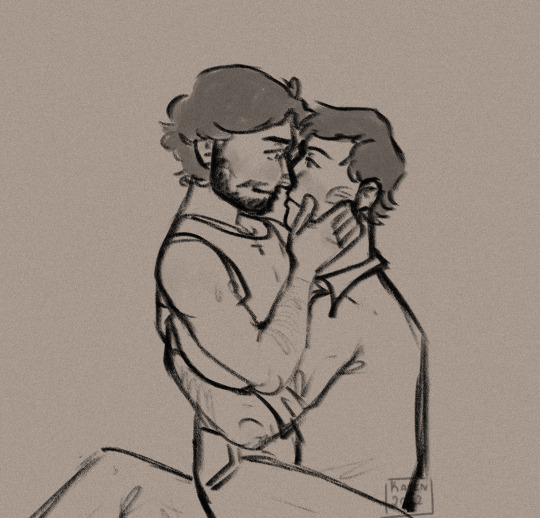
Here's the latest shipart I've done with them!
7 notes
·
View notes
Note
What things does Michał like? What are his dislikes? Aaaand tell me about Lynka's family :>
OHHH, HERE WE GO!! From this he likes... certainly taking care of flowers!! Back in the day, one of the requirements to live in a house in Giszowiec was to take care of the flowers in the garden (all of them also had roses from what I heard, btw). His mother did it, and so does Michał. But it isn't only something he has to do, he wholeheartedly loves it!! Also helps him de-stress. His biggest hobby. Another thing he's a fan of is hockey!! I don't know, but a lot of people here like hockey XD his favorite team is Naprzód Janów, which comes from here too. He also likes Budka Suflera and Maanam – two bands from the times of Polish People's Republic. Fave songs from these bands are "Lepiej bądź na tak" and "Lipstick on the Glass", respectively. Things he dislikes... WARSAW. DEFINITELY WARSAW. It's just a very Silesian thing to do. Since Poles used Silesians in MAAANY ways, why can't he just hate them? Varsovians are all snooty, and don't understand that Silesians can be different from them. Not to mention the fact they tried to eradicate Silesian language and culture. Theeen Eliasz came into his life and some things changed. He still isn't fond of the capital, but Eliasz took him there once in 1995 – it was actually the first time Michał visited Warsaw. Another one is the government itself. There are many reasons for this, from the fact that as a gay man he has to hide from them, or that they destroyed half of the original buildings in Giszowiec (cough comrade Grudzień cough). And you know, martial law. From more lighthearted things – Ruch Chorzów. They act like monkeys. He doesn't even like soccer, but he dislikes Ruch Chorzów.
Lynka's family!! Lynka comes from the Ambroz household, and was actually born in the suburbs of Katowice/Kattowitz. She was the third child of Alfons and Teresa Ambroz, and she had four younger siblings. She was raised in a typical Silesian household from those times – speaking Polish, keeping Polish traditions, Catholic. She had a close bond with her siblings, especially her sisters. As Lynka always had a really long hair (at one point around tailbone length), her sisters helped her brush it. When Giszowiec was build to house the workers of the coal mine "Giesche" (KWK "Giesche"; later "Wieczorek") and their families, she moved here with hers. Her father and brothers worked as miners, while she along with her mother and sisters took care of the house and made the meals – in general, she was taught how to be a good housewife (not that she was mad at them for that, she never saw herself in a normal job, even after women were given their rights). After she started dating Hanik Dytko, her parents were so happy she found somebody who a) isn't German, b) made her happy. She kept in touch with her family when she got married (Hanik promised her to do it as soon as Silesia becomes Polish again), but after she emigrated to the US in 1939, they lost the contact. Sometimes, she still wondered what happened to them – did they survived the war? Were they safe? And happy?
#THANK YOU SO MUCH FOR ASKING!!#michał#lynka#eliasz#hanik#tagging them all#ask#not art#i talk sometimes#jic i don't hate warsaw it's just character's views I don't condone#warsaw is pretty cool i guess#i was there once idk#dieselsardine
7 notes
·
View notes
Text


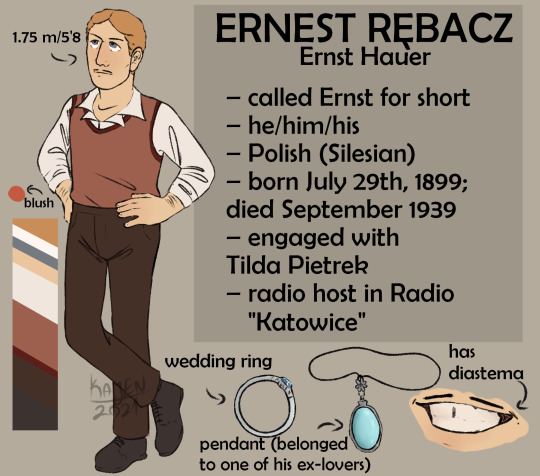
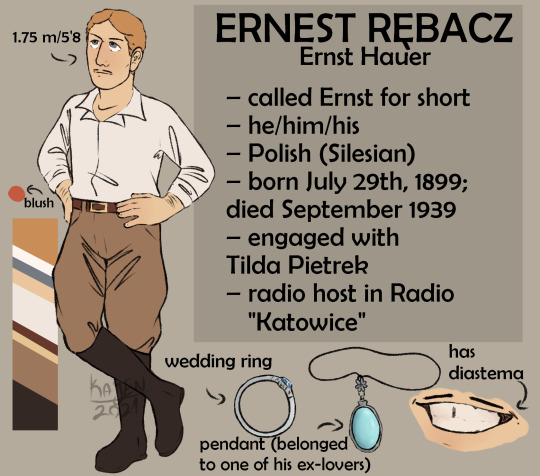
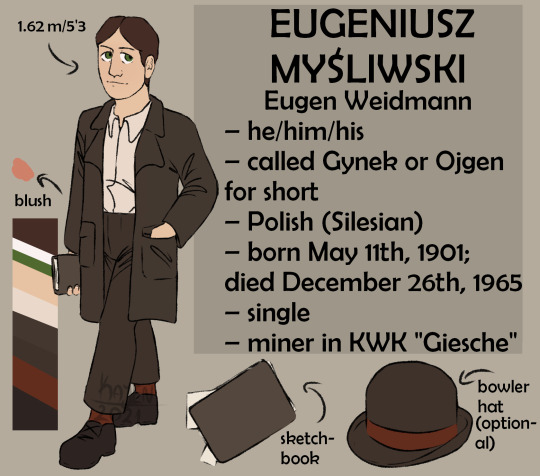
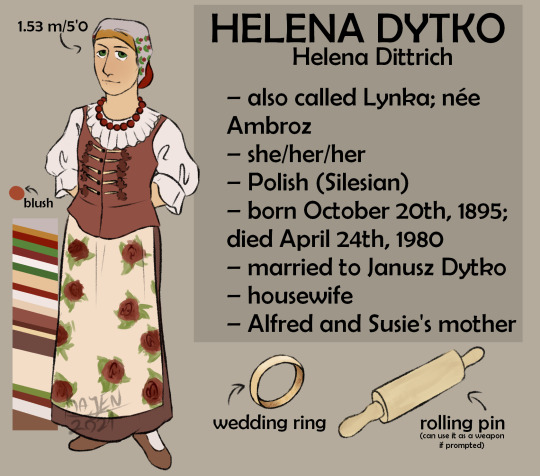
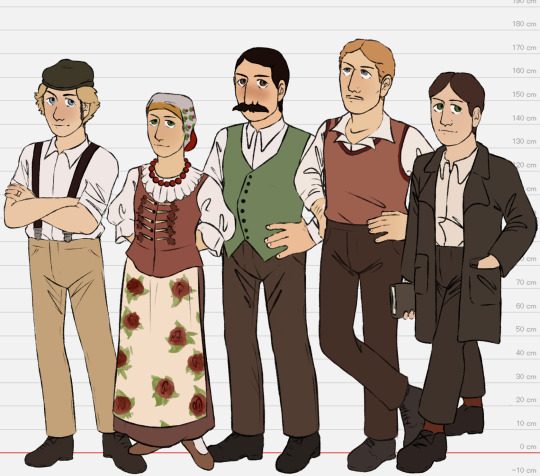
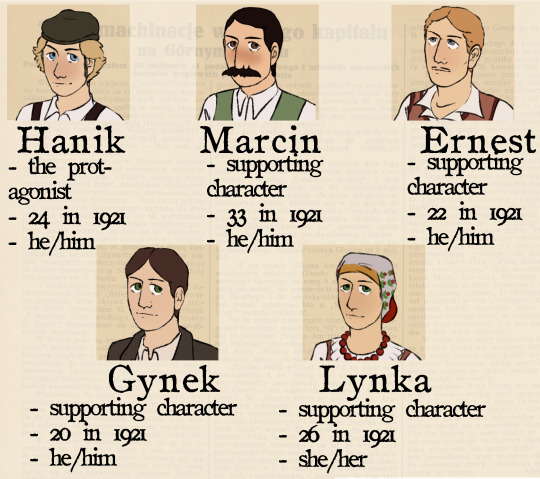
Hello! I have finally decided to introduce my OCs and story to a larger public. The universe takes place in Silesia (mostly Katowice) through the whole 20th century, and some 21st c. too. Here we have characters from the interwar period. Feel free to ask them/ask me about them about everything! I love sharing my ideas with people. 🗡️ Janusz Dytko 🗡️ Hanik, Hanzlik or Janek. Whatever. Just not Johannes. Hanik is the main character of the story, during the 1920s and 1930s arcs. He lives in Giszowiec (estate of Katowice, Poland) since 1917, and he works as a miner in KWK “Giesche” (coalmine “Giesche”) in Nikiszowiec. He fought in all three Silesian Uprisings. He is a very extroverted person, and there’s almost always a smile on his face – either a pure one or cocky one. Hanik is short-tempered, and easy to unnerve – especially if you’re German. His hobby is collecting various knives (Finnish knives, hunting, whatever he gets his hands on) and raising pigeons.
🍻 Marcin Niedźwiecki 🍻 Caressingly called “Cinek” by his friends, but try to call him like that, and he can break your fingers. Supporting character. Just like Hanik, he works on KWK “Giesche” as a miner, fought in all three Silesian Uprisings as well. As he’s not married, he lives in a miners' hotel in Giszowiec. Born in 1888. He’s an oasis of calm, Marcin is rather insular, and his mustache covering his mouth gives him even more dignity. Sometimes he’s tired of the impulsive characters of Hanik and Ernest. His family wanted him to become a priest, but Marcin preferred to become a miner. He can play grand piano, as he was taught by his mother in childhood. He’s asexual aromantic.
🍷 Ernest Rębacz 🍷 Ernest is another supporting character. In short Ernst, but it doesn’t make much of a difference. Even though he isn’t a miner – he works in radio “Katowice” since it’s establishment in 1927 – he also fought in second and third Silesian Uprising. During those events, he met Hanik and Marcin, and they’ve been friends since. Ernest is a womanizer, who doesn’t looks for long or devoted romances. He’s a hobbyist horse rider. Just like Hanik, he has a rather volatile personality. He often replies with irony or sarcasm, and he often has a smirk on his face. 🎨 Eugeniusz Myśliwski 🎨 Gynek or Ojgen in short; using his full name, you can make him embarrassed. Supporting character. Gynek was born in Cieszyn in 1901, and despite his young age, he decided to go to Annaberg to fight in the third Silesian Uprising. There he met Hanik, Marcin and Ernest, with whom he came back to Giszowiec – after the uprising, he had nowhere to go. Gynek is working on coalmine “Giesche” too, as well as a young, talented naïve artist. He never attended art school, so he doesn’t know if he can call himself an artist. Like Marcin, he lives in a miners’ hotel. A shy boy, typically self-conscious. Bisexual.
🍳 Helena Dytko 🍳 Known to everyone as Lynka. Really supporting characters; she’s Hanik’s wife. The man promised her to get married as soon as Silesia becomes part of Poland again, which happened in 1922.
She’s a housewife, who takes care of their home in Giszowiec. Lynka can be described as chopiona – a woman wearing traditional Silesian clothing. Despite her small posture, and work which isn’t hard to many, she perfectly knows how to get her way. Energetic and friendly individual, although she can point out your dirty shoes on a freshly cleaned floor. Or wet coat. She had good intuition. She knows how to operate basic weaponry, and if there is a need, she can use a frying pan or a rolling pin as a weapon if prompted to.
#oc#my oc#original character#own character#oc art#oc artwork#oc intro#oc introduction#historical oc#history oc#oc reference#oc ref sheet#ref sheet#reference sheet#oc info#hanik#marcin#ernst#ojgen#lynka#1920s#1930s#art#digital#drawing#digital art#artwork#digital drawing#digital artwork#own art
11 notes
·
View notes
Text
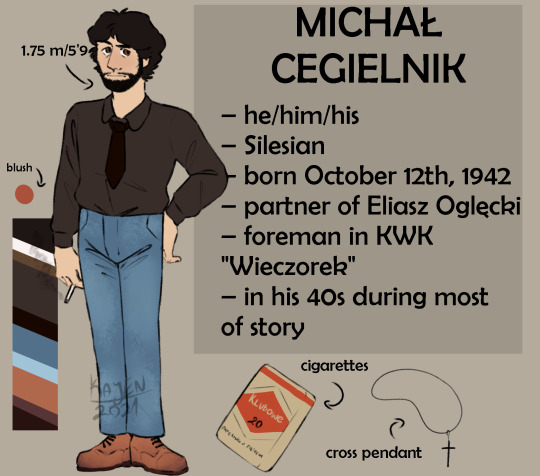

Hello hi, here I am with yet another OC intro! This time we're skipping from the 1920s to the protagonist and deuteragonist of the 1980s arc! Michał and Eliasz. They're gay. In secret of course. Like always, feel free to ask me questions about them. ⚒️ Michał Cegielnik ⚒️ He's the protagonist of the story during the 1980s arcs; he is one of the main characters in general as well! I focus on him a lot. Michał is the foreman at coal mine "Wieczorek". He’s Silesian, half-German, trying to still preserve Silesian traditions in those times. A sassy and bitter person with a realistically-pessimistic approach to life, trying to lead as normal life as he can in the Polish People’s Republic, despite its realities. Big fan of Budka Suflera band. He spent his entire life in Giszowiec. Michał smokes A LOT. He is a gay man, and his partner is Eliasz Oglęcki. He isn’t fond of Warsaw, and dislikes most things related to the capital (ironically, his partner is from Warsaw). He's childhood friends with Krzysztof Parczewski and Stanisław Mochowski. His personality is based on the attire of a typical foreman in the mine. 📻 Eliasz Oglęcki 📻 He is the deuteragonist of the story during the 1980s arcs, and he is one of the main characters in general too. I also focus on him a lot! Eliasz moved with his family from Warsaw to Katowice to work as a miner in the coal mine "Wieczorek". He is the current partner of Michał, ex-husband of Alicja Natys and father of Wojciech Oglęcki. He and Alicja got divorced in 1979, and he’s been with Michał since 1981. Eliasz is a calm and caring individual, who also seems to get embarrassed easily and is quite squishy in his relationship. He is a very polite person, who keeps his manners and refers to almost everybody by sir/madam. He’s good at general science.
#oc#my oc#original character#own character#oc art#oc artwork#oc intro#oc introduction#historical oc#history oc#oc reference#oc ref sheet#ref sheet#reference sheet#oc info#michał#eliasz#1970s#1980s#art#digital#drawing#digital art#artwork#digital drawing#digital artwork#own art#mine#my art#artist on tumblr
3 notes
·
View notes
Note
you should write a short biography for all of them and post it here :D
I already did a couple of months before, buuuuut here we go again!!
➼ Hanik He's the protagonist of the story during the 1920s! An energetic and extroverted, optimistic, a bit of happy-go-lucky person, there's always a smile on his face – either genuine or a cocky one. Super patriotic, always considered himself Pole first, then Silesian. Hates Germans. He's a miner in the coal mine "Giesche" (later "Wieczorek"). He's the husband of Helena Dytko. Can imagine him acting against commandant's orders during the fights two or three times. He's 24 during the story :o)
➼ Marcin The oldest of the group, born in 1888 (33 during the story), he's also their voice of reason™️. He was raised in a rather wealthy family, which wanted him to become a priest, but decided to lead a life of a simple miner instead (works in the same coal mine as Hanik). Oasis of calm, it's really hard to provoke him. A good balance to the volatile characters of Hanik and Ernst. He served during WW1, where he got shot between ribs – miraculously managed to survive. That's why he has a German uniform on the ref. He's asexual and aromantic! Good at playing various card games – almost nobody in Giszowiec can beat him.
➼ Ernst Ernst is many things: a womanizer, unprofessional horse rider, and a radio host in radio "Katowice". He doesn't look for long or devoted romances, often has one-night stands – everybody else is TIRED of hearing about them. He comes from Bytom, but moved to Katowice with his family, and later fought in the second and third Silesian Uprising – that's how he met Hanik and Marcin, and they've been friends since. A sarcastic person, he loves to tease others with his irony. 22 during the events of the 1920s arc. Owns a horse named Dakota.
➼ Gynek He's the youngest of the group, born in Cieszyn in 1901. He decided to fight in the third Silesian Uprising because he was kicked out of his house and had nowhere to go. After the uprising, he was offered to come to Giszowiec with Hanik, Marcin and Ernst, where he began to work in the coal mine "Giesche". He's a young, talented, naïve artist. He never attended art school, so he doesn’t know if he can call himself an artist at all. He's shy and really self-conscious, but despite that, he also fought bravely against Germans. He's bisexual.
Uff, I guess that is it! Now you know them a bit.... if you want more info, I have a whole Toyhouse dedicated to my characters. Thank you for asking!
0 notes
Photo

Ryanair ha lanciato un’offerta pazzesca. Ben 50mila voli super low cost a partire da 5 euro (a tratta). Inutile dire che il sito della compagnia aerea irlandese è andato letteralmente in tilt. L’offerta è limitata nel tempo: si può premotare entro la mezzanotte del 2 dicembre in occasione del cosiddetto “Cyber Monday”, il lunedì delle offerte low cost online. Si può viaggiare fin da subito e fino a gennaio 2020. Tantissimi i voli da Milano Bergamo. Il nostro consiglio, come sempre, è di prenotare per una meta insolita, così da avere più possibilità di trovare biglietti ancora disponibili. Tra le mete meno battute dai turisti c’è per esempio Katowice, in Polonia. È una delle città più giovani d’Europa La città polacca è un grande esempio di arte moderna e Art Nouveau. Il centro ospita molti edifici in stile Art Nouveau; la zona Sud, invece, presenta grandi esempi di edifici moderni. Katowice Rynek è la parte più vecchia e dove sono concentrati la maggior parte dei monumenti della città. Restano ancora molte delle fabbriche del XIX secolo costruite durante il boom industriale della città. Quelle di Nikiszowiec e Giszowiec sono esempi architettonici di grande importanza. Davvero un’idea originale per un weekend. Perché, invece, non scegliere una destinazione fuori stagione come Salonicco? Una città dalle numerose tracce storiche, la si può scoprire attraverso alcuni dei suoi imperedibili siti. Primo fra tutti la Chiesa di San Demetrio, patrono di Salonicco, poi la Torre bianca, simbolo della città e infine il Museo archeologico. E, infine, siete mai stati a Eindhoven in Olanda? È una città bellissi.ma, specie se siete appassionati di architettura. Il simbolo della città sono i Birilli volanti. Si tratta di un’installazione d’arte monumentale, che dimostra come i cittadini e le amministrazioni locali abbiano cercato di valorizzare tutto ciò che questa piccola cittadina è in grado di offrire. La tecnologia nell’architettura degli edifici moderni di Eindhoven è una delle cose che più vi lascerà a bocca aperta. Che si parli dell’Evoluon, centro congressi chiamato anche disco volante, del grattacielo Vesteda pieno di nuovi appartamenti, o del futuristico Blob, la scelta non manca. In effetti, una delle caratteristiche di Eindhoven è la miscela tra arte moderna ed arte tradizionale, che non passa inosservata. https://ift.tt/2LeDjGH Ryanair, offerta pazzesca: voli a partire da 5 euro Ryanair ha lanciato un’offerta pazzesca. Ben 50mila voli super low cost a partire da 5 euro (a tratta). Inutile dire che il sito della compagnia aerea irlandese è andato letteralmente in tilt. L’offerta è limitata nel tempo: si può premotare entro la mezzanotte del 2 dicembre in occasione del cosiddetto “Cyber Monday”, il lunedì delle offerte low cost online. Si può viaggiare fin da subito e fino a gennaio 2020. Tantissimi i voli da Milano Bergamo. Il nostro consiglio, come sempre, è di prenotare per una meta insolita, così da avere più possibilità di trovare biglietti ancora disponibili. Tra le mete meno battute dai turisti c’è per esempio Katowice, in Polonia. È una delle città più giovani d’Europa La città polacca è un grande esempio di arte moderna e Art Nouveau. Il centro ospita molti edifici in stile Art Nouveau; la zona Sud, invece, presenta grandi esempi di edifici moderni. Katowice Rynek è la parte più vecchia e dove sono concentrati la maggior parte dei monumenti della città. Restano ancora molte delle fabbriche del XIX secolo costruite durante il boom industriale della città. Quelle di Nikiszowiec e Giszowiec sono esempi architettonici di grande importanza. Davvero un’idea originale per un weekend. Perché, invece, non scegliere una destinazione fuori stagione come Salonicco? Una città dalle numerose tracce storiche, la si può scoprire attraverso alcuni dei suoi imperedibili siti. Primo fra tutti la Chiesa di San Demetrio, patrono di Salonicco, poi la Torre bianca, simbolo della città e infine il Museo archeologico. E, infine, siete mai stati a Eindhoven in Olanda? È una città bellissi.ma, specie se siete appassionati di architettura. Il simbolo della città sono i Birilli volanti. Si tratta di un’installazione d’arte monumentale, che dimostra come i cittadini e le amministrazioni locali abbiano cercato di valorizzare tutto ciò che questa piccola cittadina è in grado di offrire. La tecnologia nell’architettura degli edifici moderni di Eindhoven è una delle cose che più vi lascerà a bocca aperta. Che si parli dell’Evoluon, centro congressi chiamato anche disco volante, del grattacielo Vesteda pieno di nuovi appartamenti, o del futuristico Blob, la scelta non manca. In effetti, una delle caratteristiche di Eindhoven è la miscela tra arte moderna ed arte tradizionale, che non passa inosservata. Ben 50mila voli super low cost da prenostri consiglro la mezzanotte del 2 dicembre per il “Cyber Monday”. Ecco i nostri consigli di viaggio.
0 notes